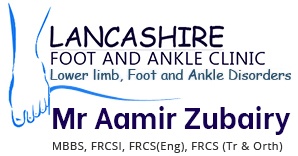What is a Bunion?
Bunion (or Hallux Valgus) is one of the most common forefoot deformity. The bone under the big toe displaces turning the big toe towards the smaller toes. This shifting of the bones causes a bony prominence on the side of the foot called Bunion.
What causes a Bunion?
Bunions may run in families. There is increased risk of developing a Bunion where your parent or grandparent had one. Bunion is more common in people with more flexible joints. They are also commoner in women than in men. Actual cause unfortunately is still unknown.
Shoes which squeeze the big toe or do not fit properly, or have an excessively high heel, may help to develop the deformity in people with family history. Bunions are much less common in people who do not wear shoes e.g certain parts of Africa.
What can I do if I have a Bunion?
Many people with bunions are quite comfortable provided that they wear wide, well fitting shoes. The shoes tend to adapt to the shape of the feet making bunion less troublesome. High heels tend to squeeze the foot into the front of the shoe and should be avoided. The surgical treatment is only required when the Bunion remains painful in spite of the above mentioned measures.
Is it possible to have minimally invasive surgery (MIS) for my Bunion?
Not all bunions can be treated with this technique. Your surgeon will examine and assess your foot for suitability for this type of surgery. Read NICE guidance on the use of this procedure.
Suitability for minimally invasive forefoot surgery:
Specialist expertise ensures that treatment is most appropriate for each individual patient. After having a specialist consultation & assessment we can advise whether minimally invasive forefoot surgery is appropriate for you. Typically, patients with mild to moderate deformities are suitable for this type of ‘keyhole’ surgery.
Our surgeon provides expert advice on all aspects of foot & ankle surgery. His aim is to ensure that the treatment he provides at his clinic leads to the best possible outcome for our patients.
How is minimally invasive forefoot surgery performed?
The surgeon makes 3 mm incisions through which to perform the correction using a 2 mm diameter cutting device to shave or cut the bone in a controlled manner under x-ray guidance.
Where shaving excess bone from the foot the surgeon then carefully removes this unwanted bone. If a correction is needed the correct position is attained and a screw is placed in the bone to maintain this position until the bone heals. These screws are small and designed to sit inside the bone reducing their need for removal.
It is important that minimally invasive forefoot surgery is carried out by a specialist foot and ankle surgeon with extensive experience of open forefoot surgery, which forms the fundamentals of this technique.






